Purpose
Managing research funding schemes (Outcome 1, Programmes 1.1 and 1.2)
Description
The ARC administers the National Competitive Grants Programme (NCGP). The NCGP comprises two programmes, Discovery and Linkage, under which the ARC funds a range of research funding schemes that support excellent, internationally competitive research projects, fellowships and awards, infrastructure, hubs and centres. In 2015–16 the ARC administered the following schemes (see Appendix 1 for description):
- Discovery programme: Australian Laureate Fellowships; Discovery Early Career Researcher Award; Discovery Indigenous; Discovery Projects; and Future Fellowships
- Linkage programme: ARC Centres of Excellence; Industrial Transformation Research Hubs; Industrial Transformation Training Centres; Linkage Infrastructure, Equipment and Facilities; Linkage Learned Academies Special Projects; Linkage Projects; and Special Research Initiatives.
Through the research funding schemes the ARC aims to deliver outcomes of benefit to Australia and build Australia’s research capacity by: supporting excellent internationally competitive research; providing training and career opportunities for current and emerging researchers; fostering industry and other end-user engagement; supporting international collaboration; and encouraging research that will strengthen Australia’s capacity to respond to emerging priorities.
Highlights of delivery
The deliverables for the Discovery and Linkage Programmes, as identified in the 2015–16 Portfolio Budget Statements (PBS) are grants, grants management and strategic policy advice on research, research training and research partnerships (PBS pages 159;162).
In 2015–16, the ARC:
- conducted selection processes which considered 6186 proposals for NCGP funding and awarded 1227 new grants, involving 3820 researchers, worth $563 million
- administered 5287 new and ongoing grants under the NCGP, providing a total of $775 million in grant payments to administering organisations
- undertook a range of NCGP-related policy development activities (see Section 2.4 for further information).
Results
Explanatory notes
Data
|
Intended result: Outcomes of benefit to Australia
Description
Advances in knowledge and innovation make a significant contribution to Australia’s economy as well as to the health and prosperity of the Australian community. The ARC’s aim is to support the highest quality researchers to conduct research that will help deliver outcomes of benefit both in the short and longer term.
Activities
In pursuing this result in 2015–16, the ARC:
- funded the highest quality research and researchers through a competitive peer review process
- used selection criteria in its funding schemes that reflected the intended objective of delivering outcomes of benefit to Australia
- asked researchers applying for ARC funding to describe the impact of their proposed research project where impact is defined as ‘the demonstrable contribution that research makes to the economy, society, culture, national security, public policy or services, health, the environment, or quality of life, beyond contributions to academia’.
Performance
|
Measure 1 |
Evidence of economic, environmental, social, health and/or |
|
|
Source |
CP 2015–19 page 25; PBS 2015–16 pages 160 and 162 |
|
|
Target |
Identification of at least 15 case studies annually |
|
|
Results |
Discovery and Linkage Programmes: Sixteen case studies are provided at the end of this section. |
Target met |
Analysis
The case studies on pages 42-58 demonstrate the breadth of outcomes resulting from ARC-funded research. In brief, the case studies outline research which is:
- contributing to important international scientific advances in the discovery of gravitational waves (Case study 1)
- using maths and virtual reality to help protect endangered animals (Case study 2)
- supporting an aging population with innovative technology (Case study 3)
- developing techniques for producing more cost-effective drugs (Case study 4)
- assisting farmers to access new economic opportunities (Case study 5)
- investigating alternative sustainable energy sources (Case study 6)
- helping to manufacture more environmentally-friendly pesticides (Case study 7)
- inventing new ultra-lightweight materials (Case study 8)
- improving access by rural and regional communities to professional artistic productions (Case study 9)
- developing clean energy technologies (Case study 10)
- creating the next generation of high-resolution microscopes (Case study 11)
- inventing materials that can remove toxic mercury from groundwater and soil (Case study 12)
- broadening our understanding of Indigenous languages and cultures (Case study 13)
- investigating printing sensors to monitor sun exposure (Case study 14)
- using big data to support the mining industry (Case study 15)
- revolutionising bone replacement with the help of 3D printing (Case study 16).
|
Measure 2 |
Proportion of completed NCGP research projects that report their objectives were met |
|
|
Source |
CP 2015–19 page 25; PBS 2015–16 pages 160 and 162 |
|
|
Target |
Greater than 95 per cent (Discovery and Linkage Programmes) |
|
|
Results |
Discovery Programme: 99 per cent |
Target met |
|
Linkage Programme: 99 per cent |
Target met |
|
Analysis
The case studies identified in response to Measure 1 provide a snapshot of the outcomes achieved from ARC-funded research every year. Information drawn from completed research projects shows that almost all (99 per cent) of the projects funded by the ARC achieve the objectives they set out to meet.
Intended result: Building Australia’s research capacity by supporting excellent research and researchers
Description
Funding excellent research and researchers will help build and maintain a world-class research base in Australia; facilitating the development of collaborative research partnerships as well as opportunities for investment by end-users including industry. The ARC’s aim is to provide funding support for the highest quality research and researchers.
Activities
In pursuing this result in 2015–16, the ARC:
- administered a rigorous peer review process involving national and international assessors
- supported participation in the NCGP by researchers from both Australia and overseas, at all career stages and from under-represented groups.
Performance
|
Measure 3 |
Proportion of Category 1 research income associated with world standard research |
|
|
Source |
CP 2015-19 page 25; PBS 2015–16 pages 160 and 162 |
|
|
Target |
Maintain or increase the proportion of Category 1 research income associated with world standard research (Discovery and Linkage Programme) |
|
|
Results |
The ARC has decided to discontinue use of this measure. Further information is provided below. |
Target not measured |
Analysis
During 2015–16, the ARC conducted additional analysis of its performance measures. As a result of that analysis, the ARC decided to discontinue use of this measure. While the contribution that ARC funding makes to all the Higher Education Research Data Collection Category 1 income can be reported (46 per cent or $2.241 billion out of a total of $4.821 billion), this cannot be linked directly to the standard of the research.
In the absence of the analyses proposed for Measure 3, outputs of research are used as an indicator of research excellence. During the year the ARC continued to collect information on the outputs of ARC-funded research projects through final reports submitted to the agency. Under the Discovery and Linkage Programmes, research projects and fellowships initially funded in 2011 produced on average 10.8 academic outputs per project as well as a total of 59 commercialisation outputs including four startup companies.
These results were obtained within the first 12 months of finalisation of the project, and can be viewed as early commercialisation outputs with the final results likely to be higher.
|
Measure 4 |
ARC-funded researchers win prestigious prizes and awards |
|
|
Source |
CP 2015-19 page 25; PBS 2015–16 pages 160 and 162 |
|
|
Target |
ARC-funded researchers win prestigious prizes and awards |
|
|
Results |
Discovery and Linkage Programmes: Examples of 2015–16 prizes and awards won by ARC-funded researchers are provided in Appendix 3 |
Target met |
Analysis
ARC funding is awarded to the highest quality research proposals as assessed against a range of criteria including (depending on the scheme) the excellence of the research proposed and the investigators involved (as judged on the basis of performance evidence against research opportunity).
External acknowledgement is considered to be a proxy indicator of the excellence of researchers. ARC-funded researchers have a strong record of winning prizes and awards (as reported in previous annual reports) and this continued in 2015–16.
Prizes and awards covered all career ages, from early career researchers (for example, through the State Young Tall Poppy Awards) to more established researchers (the Prime Minister’s Science Prizes).
Intended result: Building Australia’s research capacity by supporting research training and career development
Description
Research performance is critically dependent on access to highly qualified and skilled personnel. The ARC’s aim is to foster research training and career development opportunities through its funding schemes, including opportunities under its Linkage Programme for researchers to spend time in industry organisations.
Activities
In pursuing this result in 2015–16, the ARC:
- provided support directly, through:
- awards and fellowships to selected individuals at all career stages
- the Industrial Transformation Training Centres scheme, which is specifically targeted at funding HDR students conducting research in Industrial Transformation priority areas
- funding for postgraduate and postdoctoral researchers to work in teams with the world-class researchers awarded Australian Laureate Fellowships
- provided support indirectly, through other ARC-funded research projects (including Discovery Projects and Linkage Projects, and ARC Centres of Excellence).
In addition, the ARC continued to:
- encourage international applicants by making all ARC fellowship and award schemes open to the best researchers whether they are already located in Australia or attracted to come to Australia from overseas (including returning Australians)
- implement Research Opportunity and Performance Evidence (ROPE) as a selection criterion under all its funding schemes. ROPE requires assessors to look at opportunities available to a researcher when considering their track record
- administer the Discovery Indigenous scheme, which supports research programmes led by Aboriginal and Torres Strait Islander researchers and aims to build the research capacity of higher degree research students and early career researchers.
Performance
|
Measure 5 |
Number of early career researchers supported under ARC-funded research |
|
|
Source |
CP 2015-19 page 25; PBS 2015–16 pages 160 and 163 |
|
|
Target |
Maintain or increase the proportion of early career researchers supported under ARC-funded research (where the ARC defines an early career researcher as a researcher within five years of award of a PhD) (Discovery Programme: Discovery Early Career Researcher Award; Discovery Indigenous and Discovery Projects. Linkage Programme: Linkage Projects) |
|
|
Results |
Discovery Programme (as above): 21 per cent in 2015–16 (the same as the four-year average) |
Target met |
|
Linkage Projects: 11 per cent in 2015–16 (slightly less than the the four-year average of 12 per cent) |
Target not met |
|
Analysis
In 2015–16, the ARC maintained the proportion of early career researchers supported under the Discovery and Linkage Programmes at previous levels.
The Discovery Programme figure is higher than the Linkage Programme figure because the Discovery Programme includes the Discovery Early Career Researchers Award scheme, a scheme specifically targeted at supporting early-career researchers. The Discovery Programme also includes the Discovery Projects scheme which is the ARC’s main scheme for supporting individual researchers or teams of researchers.
Figure 2.1: Proportion of early career researchers, 2012–13 to 2015–16
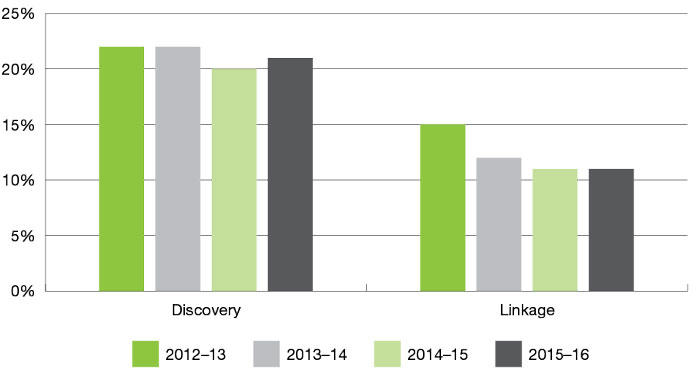
|
Measure 6 |
Proportion of ARC-funded research projects involving Higher Degree by Research (HDR) students |
|
|
Source |
CP 2015-19 page 25; PBS 2015–16 pages 160 and 163 |
|
|
Target |
Maintain or increase proportion of ARC-funded research projects involving HDR students (2015–16 is identified as the baseline year) (Discovery Programme: Discovery Indigenous, Discovery Projects, Super Science Fellowships. Linkage Programme: Linkage Projects) |
|
|
Results |
Discovery Programme (as above)—Baseline year: 72 per cent of ARC-funded research projects indicated that they involved HDR students |
Target met |
|
Linkage Projects—Baseline year: 69 per cent of ARC-funded research projects indicated that they involved HDR students |
Target met |
|
Analysis
ARC-funded research projects continued to make a significant contribution to HDR support with approximately 70 per cent of both Discovery and Linkage research proposals indicating that their research involved a HDR student.
In recent years, the ARC also started to collect data on the intent of researchers awarded ARC funding to employ PhD, Masters or Honours students. Across key Discovery schemes with grants commencing in 2015–16 (Discovery Early Career Researcher Award, Discovery Projects, Australian Laureate Fellowships and Future Fellowships) 900 research projects indicated that they would involve 1328 PhD students, 371 Masters students and 1647 Honours students.
|
Measure 7 |
Proportion of fellowship/award recipients that are international applicants |
|
|
Source |
CP 2015–19 page 25; PBS 2015–16 pages 160 and 162 |
|
|
Target |
Maintain proportion of fellowship/award recipients that are international applicants (Discovery Programme: Australian Laureate Fellowships, Discovery Early Career Researcher Award, and Future Fellowships) |
|
|
Results |
Discovery Programme (as above): 32 per cent (higher than the four-year average of 29 per cent) |
Target met |
Analysis
As noted in Figure 2.2, the proportion of ARC fellowships/awards that went to international applicants (including returning Australians and foreign nationals) fell compared to the result recorded in 2014–15 but was above the figure recorded in 2013–14.
The drop in figures between 2014–15 and 2015–16 may be influenced by (i) the outcomes of the Australian Laureate Fellowships scheme in 2015–16 under which no fellowships were awarded to international applicants, and (ii) the change to the Future Fellowships scheme noting that preference would be given to Australian researchers. The ARC will continue to look for opportunities to raise awareness of the funding opportunities available to support research activities in Australia.
Figure 2.2: International recipients of ARC fellowships and awards, 2012–13 to 2015–16
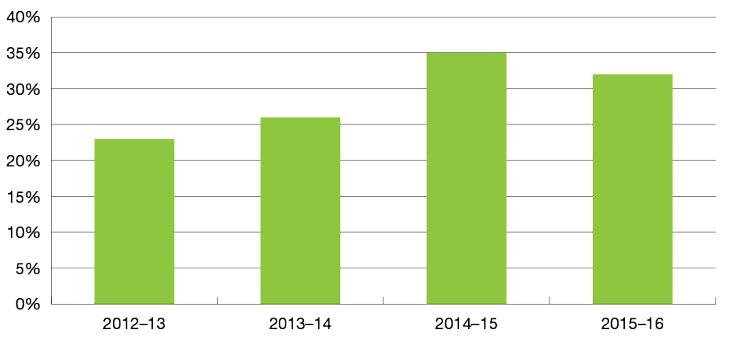
|
Measure 8 |
Number of HDR students supported under the Industrial Transformation Research Programme |
|
|
Source |
CP 2015-19 page 25; PBS2015–16 pages 160 and 163 |
|
|
Target |
Maintain or increase the number of HDR students supported under the Industrial Transformation Research Programme (Linkage Programme) |
|
|
Results |
Industrial Transformation Research Programme
|
Target met |
Analysis
The increase in Industrial Transformation Training Centres results in 2015–16 is the result of six centres being funded in that year compared to five in 2014–15 (Figure 2.3). At the same time, the average number of HDR students supported per centre has remained relatively constant. The demand for industry-linked research training remained strong in 2015–16 with the ARC receiving 28 proposals for funding under the Industrial Transformation Training Centres scheme, compared to 17 received in 2014–15.
Figure 2.3: Number of HDR students supported in training centres, 2012–13 to 2015–16
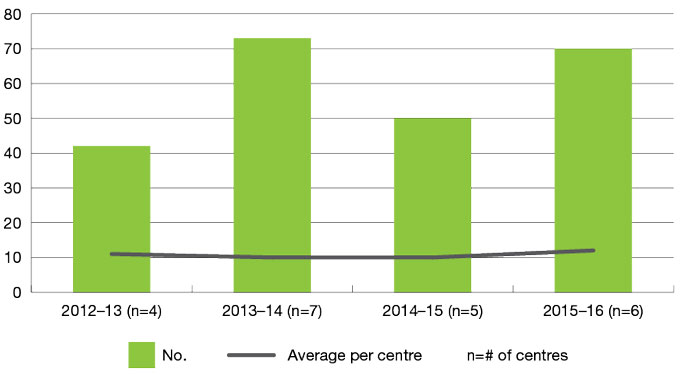
Intended result: Building Australia’s research capacity by supporting engagement between universities and other research sectors
Description
Research is a collaborative activity with successful researchers and research organisations working together, partnering and networking to generate multiplier effects. The ARC’s aim in supporting engagement between universities and other sectors, is to maximise opportunities to build the scale and focus of research involving end-users, potentially resulting in direct benefits to the community.
Description
In pursuing this result in 2015–16, the ARC continued to offer a range of funding schemes under the Linkage Programme, which is specifically aimed at supporting research collaboration. Specific mechanisms included:
- a requirement to involve partner organisations that make a contribution (either cash or in-kind or both) to the conduct of the research project
- a preference under the Linkage Infrastructure Equipment and Facilities scheme, for proposals involving multiple organisations. Single-organisation proposals must provide appropriate justification.
Performance
|
Measure 9 |
Average number of partner organisations involved in Linkage research projects |
|
|
Source |
CP 2015–19 page 26; PBS 2015–16 page 162 |
|
|
Target |
Maintain or increase the average number of partner organisations involved in Linkage research projects (Linkage Programme: Linkage Projects; Linkage Infrastructure, Equipment and Facilities; Industrial Transformation Research Programme ) |
|
|
Results |
Linkage Projects: Linkage Projects grants funded in 2015–16 involved an average of two partner organisations per grant (the same as the four-year average) |
Target met |
|
Linkage Infrastructure, Equipment and Facilities: Linkage Infrastructure, Equipment and Facilities grants funded in 2015–16 involved an average of four partner organisations per grant (the same as the four-year average) |
Target met |
|
|
Industrial Transformation Research Programme: The ITRP hubs and centres funded in 2015–16 involved an average of nine partner organisations per grant (higher than the four-year average of six partner organisations per grant) |
Target met |
|
Analysis
The average number of partner organisations involved in Linkage Programme grants is considered to be an indicator of the extent to which the Linkage schemes are encouraging collaboration between university researchers and researchers in other sectors. In 2015–16, results achieved under the Linkage Projects and Linkage Infrastructure, Equipment and Facilities schemes (average of two and four partner organisations respectively) were consistent with results achieved in previous years. Under the Industrial Transformation Research Programme, the average number continued to grow with an average of nine partner organisations recorded. The results exceeded the minimum requirements for all schemes, that is, one Australian partner organisation for proposals funded under the Industrial Transformation Research Programme; one partner organisation under the Linkage Projects scheme; and two or more eligible organisations under the Linkage Infrastructure, Equipment and Facilities scheme, unless it is a single organisation proposal and can demonstrate that collaborative use of the proposed research infrastructure is
not practicable.
Figure 2.4: Average number of partner organisations per ARC-funded research project, 2012–13 to 2015–16
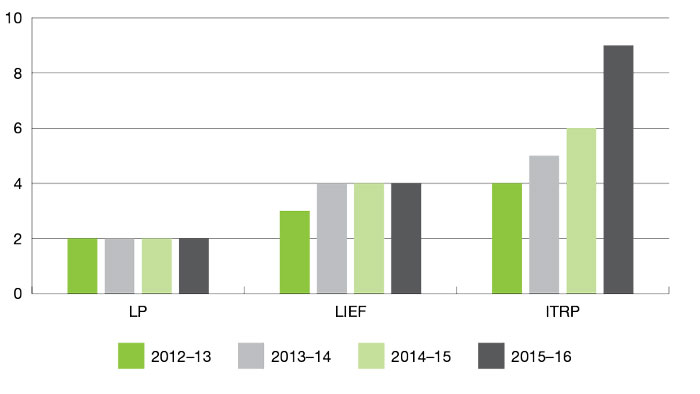
|
Measure 10 |
Linkage research projects leverage significant national |
|
|
Source |
CP 2015–19 page 26; PBS 2015–16 page 162 |
|
|
Target |
Maintain or increase funding (cash and in-kind) pledged by partner organisations (Linkage Programme: Linkage Projects; Industrial Transformation Research Hubs) |
|
|
Results |
Linkage Projects: Partner organisations pledged $1.8 for every ARC dollar |
Target not met |
|
Industrial Transformation Research Hubs: Partner organisations pledged $1.8 (above the four-year average of $1.6) |
Target met |
|
Analysis
Under the Linkage Projects and Industrial Transformation Research Hubs schemes, the combined cash and in-kind contributions pledged by partner organisations are required to at least match the funding sought from the ARC. In 2015–16, this requirement was exceeded in both schemes, with every ARC dollar attracting $1.80 from partner organisations under both schemes.
There are a range of variables potentially impacting results for the Linkage Projects scheme including: the move to one round under the Linkage Projects scheme in 2013 and increased participation by industry organisations in the ITRP schemes.
Figure 2.5: Funding pledged by partner organisations, 2012–13 to 2015–16
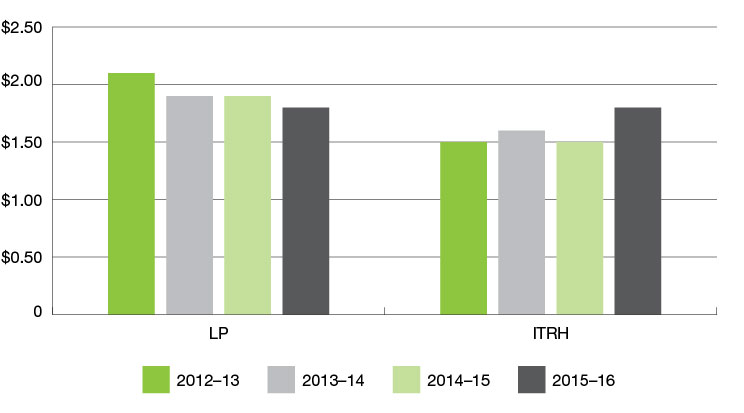
|
Measure 11 |
Linkage funding supports research projects that involve collaboration with industry |
|
|
Source |
CP 2015–19 page 26; PBS 2015–16 page 162 |
|
|
Target |
Maintain or increase the proportion of Linkage research projects that involve collaboration with industry (Linkage Programme: Linkage Projects; Industrial Transformation Research Programme) |
|
|
Results |
Linkage Projects: 59 per cent in 2015–16 |
Target not met |
|
Industrial Transformation Research Programme: 100 per cent in 2015–16 (above the four-year average |
Target met |
|
Analysis
Business or industry organisations are an important participant in the Linkage Projects scheme and Industrial Transformation Research Programme.
In 2015–16, participation by industry organisations fell slightly under the Linkage Projects scheme. There are a range of variables potentially in play in this result including: the move to one round under the Linkage Projects scheme in 2013 and increased participation by industry organisations in the ITRP schemes.
Figure 2.6: Proportion of research projects that involve collaboration with industry, 2012–13 to 2015–16
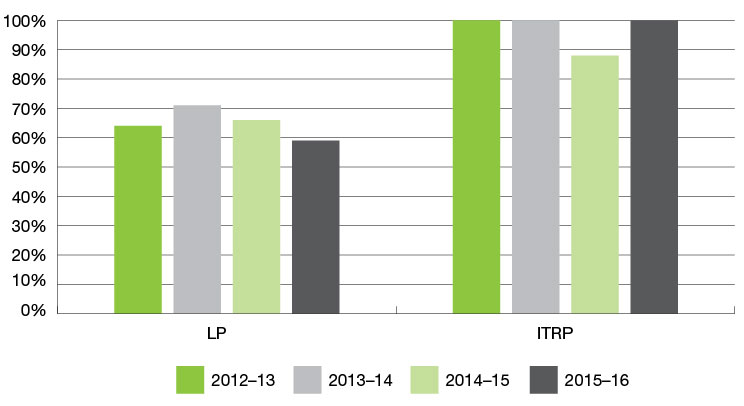
|
Measure 12 |
Partner organisations rate the research partnerships supported through Linkage research projects as being beneficial or very beneficial |
|
|
Source |
CP 2015–19 page 26; PBS 2015–16 page 162 |
|
|
Target |
Greater than 90 per cent of partner organisations rate the research partnerships supported through Linkage research projects as being beneficial or very beneficial (Linkage Programme: Linkage Projects) |
|
|
Results |
Linkage Projects: 98 per cent, compared to 99 per cent and 98 per cent in 2014–15 and 2013–14 respectively |
Target met |
Analysis
A partner organisation’s commitment of funding and other resources to a research project indicates an expectation of return from that investment. Feedback from partner organisations analysed during 2015–16 indicated that a vast majority of partners (98 per cent) found that the collaborative research had been either ‘very beneficial’ or ‘beneficial’ to their organisation (see Figure 2.7). As indicated by the historical trends, the ARC has consistently received this level of positive feedback from partner organisations about their involvement in the Linkage Projects scheme.
Partner organisations cited a wide range of benefits (including access to research expertise) and a significant proportion (91 per cent) said that the organisation would participate in research projects supported by the scheme again, if the opportunity arose. The main reasons cited for not participating the future included the wind-up of the organisation involved (five instances) and the future unavailability of funding by the organisation (two instances).
Figure 2.7: Proportion of Linkage Projects Partner Organisations that found the experience beneficial
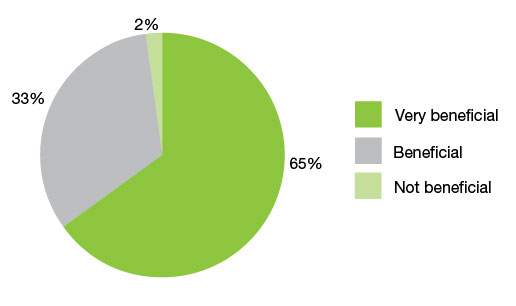
Intended result: Building Australia’s research capacity by supporting international collaboration
Description
Research is a global activity with researchers seeking access to the best partners and facilities worldwide. The ARC’s aim in supporting international research collaboration is to maximise Australia’s contribution to, and benefits from, international research collaborations, partnerships, developments and policy. Benefits include access to ideas and resources.
Activities
In pursuing this result in 2015–16, the ARC:
- identified international travel costs as eligible budget items under most NCGP funding schemes
- identified overseas organisations as eligible partner organisations under the Linkage Programme schemes
- awarded Discovery International Awards under the Discovery Projects scheme to increase opportunities for collaboration between researchers, research teams and/or research centres in Australia and overseas
- continued to foster the cooperative use of international facilities under the Linkage Infrastructure, Equipment and Facilities scheme.
Performance
|
Measure 13 |
Proportion of research projects involving international collaboration |
|
|
Source |
CP 2015–19 page 26; PBS 2015–16 pages 160 and 162 |
|
|
Target |
Maintain or increase proportion of research projects involving international collaboration (Discovery and Linkage Programmes) |
|
|
Results |
Discovery Programme: 74 per cent in 2015–16 (above the four-year average of 68 per cent) |
Target met |
|
Linkage Programme: 56 per cent in 2015–16 |
Target met |
|
Analysis
Approximately three quarters of Discovery Programme projects and over half of Linkage Programme projects commencing in 2015–16 indicated that the research would involve international collaboration. In total, approximately 2172 instances of intended international collaboration were recorded, involving over 79 countries. The United States of America was recorded most often as a country of collaboration, followed by the United Kingdom.
The proportion of ARC-funded research projects involving international collaboration has slowly increased under both the Discovery and Linkage Programmes (see Figure 2.8). For the first time in 2015–16, the ARC started collecting data (in a reportable form) on the nature of the international collaborative activities proposed. Analysis of data shows that an overwhelming majority involve substantial activities.
Figure 2.8: Proportion of ARC-funded research projects involving international collaboration, 2012–13 to 2015–16
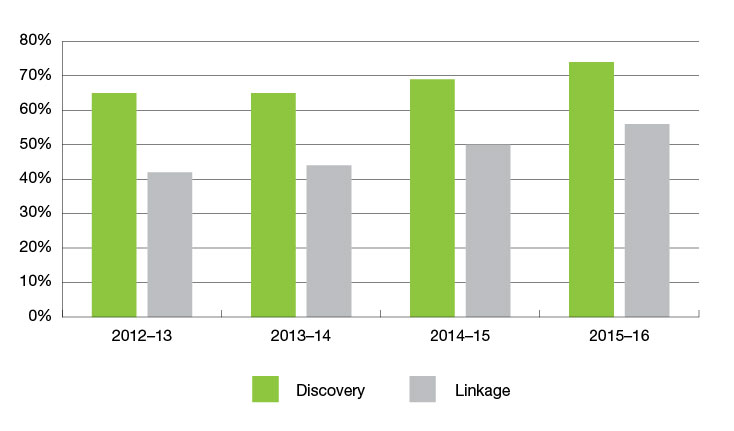
In addition to the results outlined above:
- almost one third (71/252) of research projects awarded funding under the Linkage Projects scheme involved international organisations. In total 99 international organisations were nominated as Partner Organisations on Linkage Projects grants commencing in 2015–16
- a total of 127 Discovery International Awards were awarded under the Discovery Projects scheme for funding commencing in 2016
- a number of projects awarded funding under the Linkage Infrastructure, Equipment and Facilities scheme involved international collaboration:
- Australian Membership of International Ocean Discovery Program, the world’s largest collaborative research program in earth and ocean sciences
- equipment for international collaboration in the next-generation gravitational wave detector
- coherent laser links for space applications to enable continuing leadership and involvement in international space projects.
Intended result: Building Australia’s research capacity by supporting research in areas of priority
Description
Through implementation of priority areas, the Government aims to ensure that appropriate levels of public funding are allocated to research that addresses the challenges
facing Australia.
Activities
The ARC’s aim is to contribute to the Government’s agenda of building the nation’s capacity to pursue research in identified areas of importance to Australia. In pursuing this result in 2015–15:
- all researchers applying for ARC funding were required to identify whether their research project fell within an area of research priority. While funding is not specifically directed to these areas, most schemes ask assessors to consider whether the research will address or has the potential to address these priority areas
- the ARC only funded research in identified Industrial Transformation Priority areas through the Industrial Transformation Research Programme. In 2015–16 the Industrial Transformation Priority areas included advanced manufacturing; food and agribusiness; oil, gas and energy resources; mining equipment, technology and services; and medical technologies and pharmaceuticals
- the ARC provided ongoing funding for a number of initiatives in priority areas which commenced in previous years including:
- National ICT Australia
- National Indigenous Research and Knowledges Network
- the Special Research Initiative for the Antarctic Gateway
- the Special Research Initiative for Type 1 Juvenile Diabetes
- the Special Research Initiative for the Science of Learning
- the Special Research Initiative for Synchrotron Science
- the Special Research Initiative for Tropical Health and Medicine
- Stem Cells Australia.
Performance
|
Measure 14 |
Proportion of NCGP funding awarded to research in areas of priority |
|
|
Source |
CP 2015–19 page 26; PBS 2015–16 pages 160 and 163 |
|
|
Target |
Maintain or increase the proportion of NCGP funding awarded to research in areas of priority (Discovery and Linkage Programmes) |
|
|
Results |
Discovery Programme: 80 per cent in 2015–16 (compared to the two year average of 81 per cent) |
Target not met |
|
Linkage Programme: 96 per cent in 2015–16 (compared to the two year average of 94 per cent) |
Target met |
|
Analysis
In 2015–16, a significant proportion of new research projects funded under both the Discovery and Linkage Programmes indicated that the research was relevant to one of the Australian Government’s priority areas—80 per cent of those awarded under the Discovery Programme and 96 per cent under the Linkage Programme. The Strategic Research Priority (SRP) areas were: living in a changing environment; promoting population health and wellbeing; managing our food and water assets; securing Australia’s place in a changing world; and lifting productivity and growth.
Strategic Research Priority areas only came into effect under the NCGP in 2014–15. Prior to that a different set of priorities were in place (National Research Priorities (NRP)) which explains the change in figures recorded between 2013–14 and 2014–15 (see Figure 2.9). The Government announced a new set of priorities–Science and Research Priorities—in May 2015 and the ARC will report against these priorities in 2016–17.
Figure 2.9: Proportion of ARC-funded research projects in areas of priority, 2012–13 to 2015–16
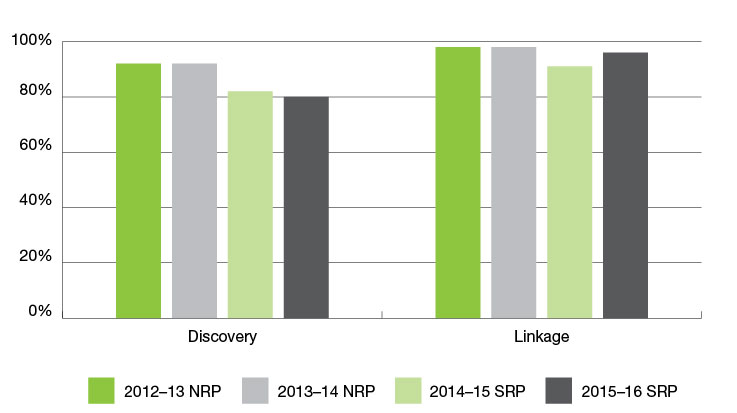
In addition, five research hubs and six training centres were awarded funding under the Industrial Transformation Research Programme. Those hubs and centres indicated that their proposed research programmes were relevant to the Industrial Transformation priority areas of advanced manufacturing (10 instances), food and agriculture (one instance), mining engineering (two instances) and medical technologies (five instances). These centres and hubs will build on the record of the 23 hubs and 16 centres established as a result of previous selection rounds.
Progress was also reported in a number of initiatives in priority areas:
- Together with the NHMRC, the ARC announced the funding outcomes for the joint dementia fellowships, which is part of the Government’s $200 million Boosting Dementia Research initiative.
- The Juvenile Diabetes Research Foundation announced the funding outcomes for $14 million (of the $35 million) allocated to the Foundation under the Special Research Initiative for Type 1 Juvenile Diabetes. A total of 51 new grants were awarded to researchers looking for a cure for type 1 juvenile diabetes.
- The Synchrotron reported discoveries made with the assistance of the facility, including solving ‘decades-old controversies on how ‘friendly fire’ of the immune system causes deadly cerebral malaria (24 December 2015).
- Through the Antarctic Gateway Special Research Initiative, the Aurora Australis made a pioneering voyage in 2015 becoming the first ship ever to reach the edge of East Antarctica’s fastest thinning glacier—the Totten Glacier.
Intended result: Effective delivery of a high-quality competitive grants programme
Description
Efficient and effective programme delivery supports the achievement of scheme objectives. The ARC’s aim is to deliver its programmes as efficiently and effectively as possible.
In pursuing this objective in 2015–16, the ARC:
- pursued best practice peer review processes (including addressing conflicts of interest and appeals process)
- continued to look for ways to streamline electronic processing of proposals
- reviewed NCGP funding rules
- liaised regularly with institutions (including through regular emails to research administrators and information sessions and visits).
Performance
|
Measure 15 |
Cost of delivering the NCGP |
|
|
Source |
CP 2015–19 page 26 |
|
|
Target |
Cost of delivering the NCGP is at an acceptable level compared to other research funding agencies (Discovery and Linkage Programmes) |
|
|
Results |
This was not measured in 2015–16 in a way that would allow a robust assessment against the target identified. |
Target not measured |
|
Measure 16 |
Evidence of stakeholder satisfaction with delivery of the NCGP |
|
|---|---|---|
|
Source |
CP 2015–19 page 26 |
|
|
Target |
Greater than 80 per cent of stakeholders are satisfied with the delivery of the Discovery and Linkage Programmes |
|
|
Results |
This was not measured in 2015–16 in a way that would allow an assessment against the target identified. |
Target not measured |
Analysis
As noted at Measure 15, the ARC did not conduct a detailed analysis of grant administration costs in 2015–16 pending finalisation of the ARC’s Performance Framework in 2016–17. The last study, conducted in 2010–11, concluded the ARC was a very efficient organisation that compared favourably to international benchmarking of partners against each of the headline key performance indicators. These included the number of applications administered per FTE and the direct cost of grants administration as a percentage of the value of grants awarded.
Similarly, as noted at Measure 16, the ARC did not undertake any evaluations in 2015–16 that would allow it to report against the target of 80 per cent of stakeholders being satisfied with delivery of the NCGP. While the ARC did not conduct a satisfaction survey, there were a number of stakeholder engagement activities undertaken which indicated a high level of satisfaction including the Research Administrators seminar and requests for feedback on funding rules.
Highlights of the ARC’s performance in efficient and effective delivery in 2015–16 included:
- supportive feedback on IT redevelopment (see case study below)
- successful launch of the Final Reports module in RMS including the transition of a significant amount of data to the new system with limited impact for the sector
- the relatively small number of appeals relating to NCGP proposals submitted under the Discovery Projects and Future Fellowships schemes. Of the 11 appeals received, seven appeals were upheld by the NCGP Appeals Committee.
IT developmentsThe ARC relies heavily on its IT systems in delivering the NCGP. In 2015–16 the ARC completed an extensive redevelopment of functionality to include the complete grants management lifecycle within one system. This initiative transformed the services provided to the research community by the ARC by:
RMS supports the efficient and cost-effective delivery of the Discovery and Linkage programmes. Its replacement and expansion to support the full grants management lifecycle is a significant enabler to a small but materially significant entity. |
Analysis of the impact of changes on performance
There were no changes in the ARC’s purposes, activities, organisational capability or environment that impacted significantly on its performance in delivering Purpose 1: managing research funding schemes.
As noted on page 3, a key development during the year was the announcement that the ARC would be responsible for implementing a continuous application and assessment process under the Linkage Projects scheme from 1 July 2016. The addition of this new responsibility had no impact on the outcomes of the ARC’s activities in relation to other funding schemes.
As a result of this change, a new deliverable was identified for the ARC in the Additional Budget Estimates documentation—Grants (including deliverables of continuous application process for Linkage Projects). In preparation for implementation of this process the ARC consulted with stakeholders and made changes to RMS.
Case study 1: Outcomes of Benefit
Australian researchers making waves

Two Black Holes merge into one.
Image courtesy of SXS, the Simulating eXtreme Spacetimes (SXS) project (http://www.black-holes.org)
Announced early 2016, a global effort to detect ripples in the fabric of space-time, known as gravitational waves, came to fruition when scientists finally confirmed their existence. Theorised by Albert Einstein more than one hundred years ago, efforts to directly prove the existence of gravitational waves have been ongoing for over fifty years. This first observation, caused by the collision of two black holes, marks the birth of gravitational wave astronomy and is a significant boost to the understanding of fundamental physics.
Australian science and technology researchers from multiple scientific streams have made critical contributions to the breakthrough, supported by significant funding from the ARC. Since 2003, the ARC has funded almost 50 individual and collaborative projects across both the Discovery and Linkage Programmes, spanning fundamental theory and techniques in computational modelling and data analysis, through to the development of specialised instrumentation needed to detect the waves.
Since 2009, the ARC has directly supported Australia’s participation in the Advanced Laser Interferometer Gravitational-Wave Observatory (Advanced LIGO) project, a key international collaboration led by the U.S. National Science Foundation that developed the ultra-precision detectors and other instruments essential to the discovery. A total of $2.79 million for two Linkage Infrastructure, Equipment and Facilities (LIEF) grants to The Australian National University and The University of Adelaide was provided towards this project. Further LIEF funding to these institutions and the University of Western Australia has enabled Australian researchers to make important contributions to developing the extraordinary sensitivity of the instruments required for the detection, and to the development of the next generation of detectors for gravitational wave astronomy.
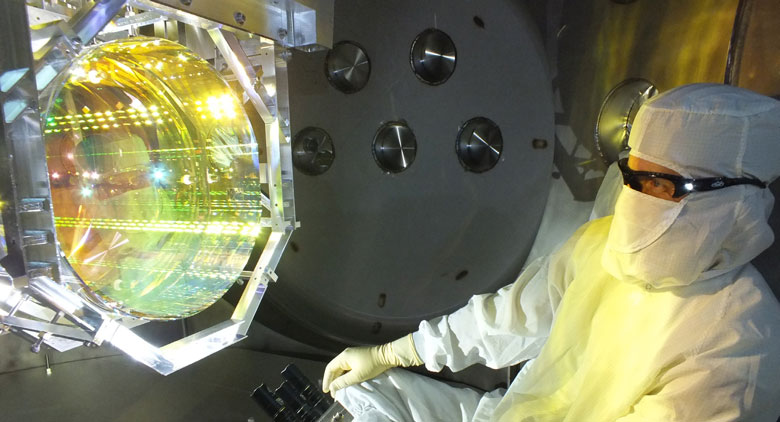
Inspecting LIGO’s optics for contaminants prior to sealing up the chamber and pumping the vacuum system down, a LIGO optics technician inspects one of LIGO’s core optics (mirrors) by illuminating its surface with light at a glancing angle. Image courtesy of Matt Heintze/Caltech/MIT/LIGO Lab
The existence of gravitational waves was confirmed again in June 2016 with a second detection of gravitational waves, which promises the ability to see the universe in a totally new way and has been described as one of the most important science discoveries of the 21st century.
“Long term support from the ARC was critical in enabling Australian researchers to play such a major role in the opening of this new window on the universe” said Prof David McClelland, leader of Australia’s Partnership in Advanced LIGO.
The involvement of Australian research and technology in this discovery reiterates Australia’s position at the frontier of science and innovation.
Case study 2: outcomes of benefit
Using virtual reality and statistics to save endangered species
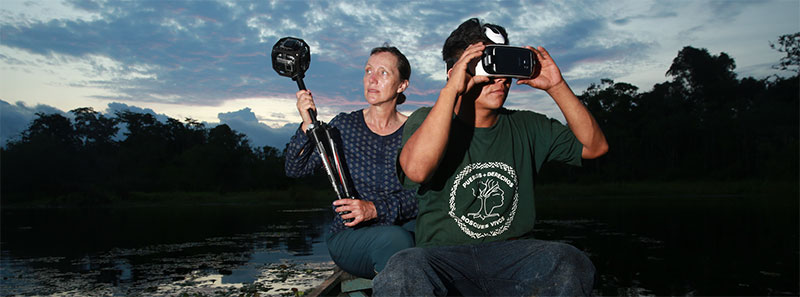
Australian Laureate Fellow Professor Kerrie Mengersen from Queensland University of Technology conducting fieldwork for the ARC Jaguar Conservation Project in Peru. Image courtesy of Vanessa Hunter
A new era of statistical modelling is using virtual reality technology to inform environmental policy and decision making as a result of the work of 2015 Australian Laureate Fellow, Professor Kerrie Mengersen.
The technique, pioneered by Professor Mengersen and a team from the Queensland University of Technology and the ARC Centre of Excellence for Mathematical and Statistical Frontiers, involves research expeditions to the Amazon and the use of 360-degree cameras to create virtual platforms. The platforms effectively enable wildlife experts from around the world to experience the location as if they were there.
In late 2015, Professor Mengersen led a group into the Peruvian jungle to collect data on jaguars, producing footage from various locations. As a result of the immersive virtual reality method, more detailed information and better quality data was extracted, contributing to improved mathematical and statistical models. The combination of information provided by experts with local knowledge, as well as other data from the field trip, enabled Professor Mengersen to form strong predictive models of the population’s behaviour and movement of this elusive threatened species.
A more complex picture and a better understanding of population trends and threats is crucial to understanding not only the animals themselves, but their environment and how they react to pressures such as mining and deforestation. With the cooperation of Peru’s government, the findings from Professor Mengersen’s research are helping define a jaguar corridor stretching from Mexico, through Central America to Argentina, and can be used to inform decision making in sustainable conservation, tourism and development.
Case study 3: outcomes of benefit
Innovation in caring for the elderly
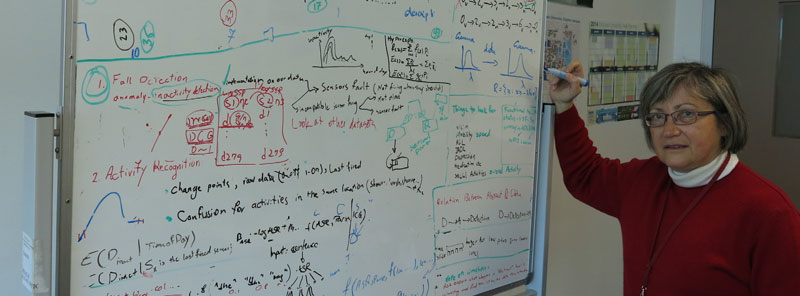
Professor Ingrid Zukerman from Monash University is combining computational models with a range of sensors to assist seniors and caregivers.
Supporting Australia’s ageing population, by effectively balancing an independent lifestyle and the availability of assistance when needed, is an increasing challenge to Australian society. A new device, however, is promising to address concerns about the wellbeing of seniors living at home. The ‘Super Sensor’–a non-intrusive monitoring device designed to assist seniors and caregivers, and its associated software, provide a technological solution that could revolutionise the aged-care industry.
Professor Ingrid Zukerman and her team from Monash University, together with Dr Masud Moshtaghi from The University of Melbourne, developed a system that combines computational models with a prototype Super Sensor that houses an array of sensors, such as passive infrared motion, light, temperature and vibration sensors. Utilising data obtained from the Super Sensor, the computational models can track and compare patterns of behaviour in order to make an assessment of the health and wellbeing of elderly residents in their own homes.
The computational models can send out alerts to carers and loved ones when potential issues, such as prolonged inactivity (for example, due to a fall), are identified. Designed to be affordable and easy to use, the system can complement the services provided by a caregiver by identifying accidents, functional decline or the onset of illness.
Initially supported by a 2010 ARC Linkage Projects grant, Professor Zukerman and her collaborators are improving the technology through a 2015 Linkage Projects grant, and will soon trial the system in hospitals and aged care facilities. With the potential to ease pressure on the aged-care sector by supporting independent living for longer, the research team is hopeful of receiving additional support from the private sector to bring the technology to the wider market.
Case study 4: outcomes of benefit
'Unboiling' eggs to fight cancer
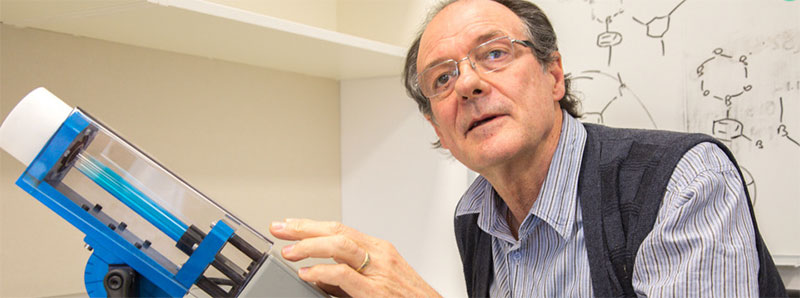
Flinders University’s Professor Colin Raston has synthesised lidocaine in his Vortex Fluidic Device (VFD). Professor Raston won an Ig Nobel prize for ‘unboiling’ an egg with the VFD.
In 2015, Professor Colin Raston and his research team were awarded an Ig Nobel Prize for partially ‘unboiling’ an egg, recognising a scientific achievement that ‘made people laugh, then made them think’. When the research team at Flinders University, in collaboration with Professor Greg Weiss at the University of California-Irvine, demonstrated this using a novel device, it unsurprisingly garnered considerable media attention. Beyond the novelty, however, this research has enormous implications for the pharmaceutical industry.
When proteins, such as albumen in eggs, are heated they ‘unravel’ from their natural conformations and clump together to form a dense substance. With the support of ARC funding, Professor Raston has developed the Vortex Fluidic Device (VFD), a machine that uses mechanical energy in thin films of liquid to reverse this process. By spinning the substance at tremendous speeds, the clumped protein molecules are able to revert to their natural shape.
The VFD has many other applications, from continuous production of biodiesel and the synthesis of drugs, to targeted drug delivery. For example, it has potential to revolutionise the use of drugs recognised by the World Health Organisation as being essential to any basic health system. One of these drugs is carboplatin, a common anti-cancer drug. The VFD has been used to increase the carboplatin’s potency, meaning less of the drug is needed, and reducing side effects for patients.
Another drug, Lidocaine, is a high demand anaesthetic which can be made in under an hour following basic instructions using the VFD. This cost-effective process, with minimal generation of waste, means that the drug could be made readily available in developing countries, where the demand for anaesthetic is high, but the facilities to produce it are not available.
Professor Raston plans to sell the VFD to research institutions all around the world, and industry, paving the way for revolutionary changes across many different areas of sciences.
Case study 5: Outcomes of Benefit
Growing opportunities for farmers
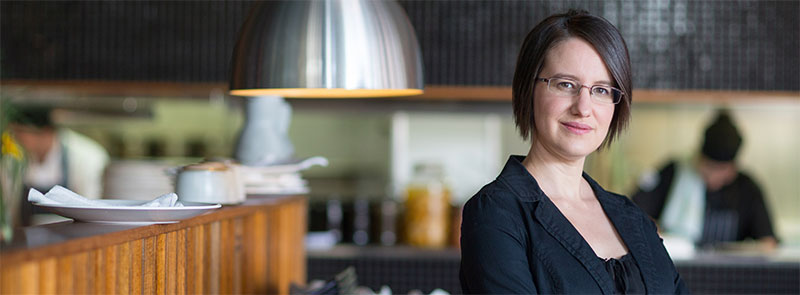
University of Tasmania Discovery Early Career Researcher Award researcher Michelle Phillipov is helping farmers access new market opportunities. Image courtesy of The University of Tasmania 2.2 Annual Performance Statement: Purpose 1
What we eat and how we experience food is undergoing significant change as a result of an intensified media focus on food. That’s according to an ARC-funded researcher who has been exploring interactions between the media and food industries as part of a Discovery Early Career Researcher Award (DECRA).
Dr Michelle Phillipov, a 2014 DECRA recipient from the University of Tasmania, is conducting research on ‘The New Politics of Food and the Australian Media’. She has been exploring the provenance and ethics of food production and consumption and how media shapes consumer expectations.
According to Dr Phillipov’s research, media and popular reality cooking shows are investing food with new meaning and significance, changing the relationship between producer and consumer. Food trends and shifting consumer demand, stimulated by the popularity of cooking reality shows, is creating opportunities for farmers and opening up new markets for food products and experiences.
In particular, Dr Phillipov has been studying the experiences of small food producers who have participated in television programs like MasterChef and Gourmet Farmer. Advice and information on how to engage consumers through media, developed by Dr Phillipov as part of her project, is now helping food producers and farmers create better marketing strategies.
Designed to help others capitalise on the opportunities presented the advice suggests ways that food producers can better promote their businesses to make the most of increased consumer interest in food trends such as seasonal eating, as well as ethical and locally produced food. For small-scale and regional producers involved in the boutique and artisan food sector, adjusting to demand from consumers who are keen to see where their food comes from means a bigger slice of what is now a multi-billion-dollar industry.
Case study 6: Outcomes of Benefit
Growing opportunities for farmers
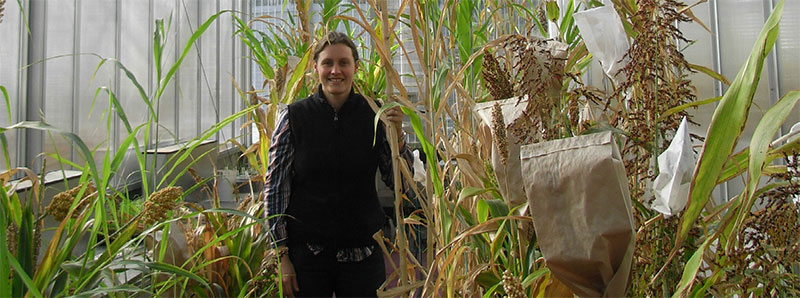
The University of Adelaide Discovery Early Career Researcher Award researcher Dr Caitlyn Byrt with some of the sorghum types studied at the Australian Research Council Centre of Excellence in Plant Cell Walls. Image courtesy of Haiyen Nguyen
With an increased focus on energy security and growing concerns about the impact of fossil fuels on the environment, researchers are looking to alternative sources of energy. But what will power tomorrow’s cars?
Research from the ARC Centre of Excellence in Plant Cell Walls at The University of Adelaide suggests that the future of fuel could be found in wild grasses such as a variety of sorghum called Arun—commonly considered a weed and found along roadsides in Northern Australia.
The Centre has found that Arun has massive potential for biofuel production. After testing both cultivated and wild varieties of sorghum, the team found that using Arun yielded significantly more glucose than other varieties. A theoretical calculation of ethanol yields for Arun proved to be more than 10,000 litres of bioethanol per hectare each year from stem tissues alone, a considerable increase on other sources of ethanol.
The researchers say that a large pool of untapped diversity exists in other species and subspecies of sorghum, opening new avenues of research to generate sorghum lines optimised for biofuel production.
Arcadia Biosciences, a US-based agricultural technology company and partner in the research, is working with the Centre to commercialise these findings and to explore the use of Arun as an alternative sustainable energy source, both in Australia and overseas.
Case study 7: Outcomes of benefit
Understanding insecticide resistance
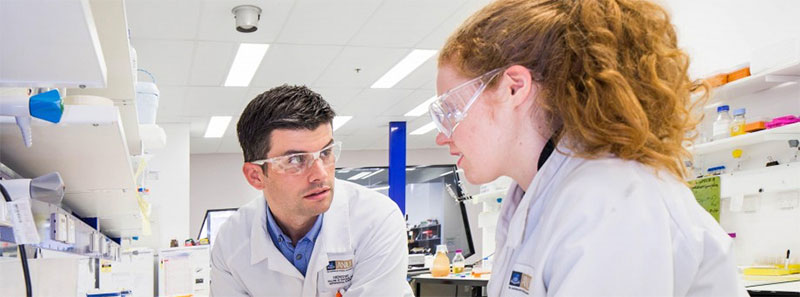
Associate Professor Colin Jackson (left), and PhD student Ms Elena Sugrue (right), discussing the outcome of an experiment and analyzing the growth of bacteria expressing an engineered insect protein for detoxification of pesticides at The Australian National University. Image courtesy of Stuart Hay
Synthetically-designed pesticides have been central to booming agricultural productivity over the last century. However, productivity has been threatened in recent times by increasing levels of pesticide resistance amongst insect populations and by the detrimental implications of pesticide misuse to environmental and human health.
Associate Professor Colin Jackson and his team at The Australian National University are undertaking pioneering research into insects’ resistance to a commonly used class of insecticides known as organophosphates. Their work engineering proteins will help manufacture chemicals in a more environmentally friendly way.
Associate Professor Jackson, who was awarded a Future Fellowship in 2014, is determining the molecular structure of proteins responsible for insecticide resistance by simulating the evolutionary processes of resistance in a laboratory setting. Using this information, he aims to develop new pesticides to combat resistance, potentially saving the agricultural industry millions of dollars each year by preventing flystrike in livestock, reducing crop infestation and curbing the spread of insect-borne diseases.
As well as being toxic to insects, organophosphates are highly toxic to humans. Associate Professor Jackson is also applying his research findings to developing an effective antidote to human organophosphate poisoning. He hopes that by exploiting the newly evolved proteins as biosensors, decontamination agents and poisoning antidotes, these problematic proteins could eventually save lives.
In recognition of his chemical science research, Associate Professor Jackson received the Royal Australian Chemical Institute’s 2015 Rennie Memorial Medal and was named the ACT Scientist of the Year.
Case study 8: Outcomes of benefit
A new ultra-light metal—the key to reducing emissions
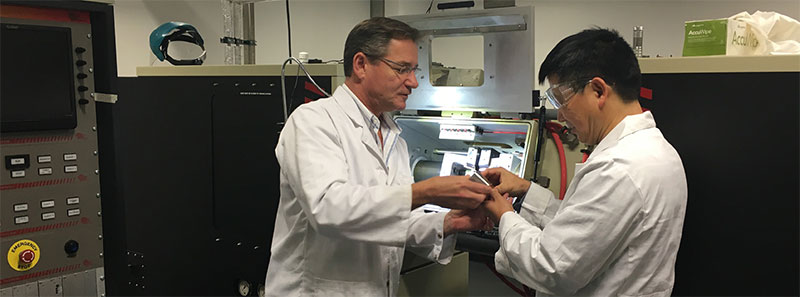
Professor Michael Ferry (left) and Dr Martin Xu (right) carrying out thermomechanical testing of the MgLi alloy using the state-of-the-art ARC-LIEF funded Gleeble 3500 Thermal and Mechanical Simulator at The University of New South Wales. Image courtesy of The University of New South Wales
Every year, the Australian transport sector produces around 90 million tonnes of greenhouse gas, representing a significant percentage of our annual greenhouse gas emissions. The great majority of these emissions come from road transport or aviation.
An international team, led by Professor Michael Ferry of The University of New South Wales, has developed a lightweight alloy addressing this problem. This novel material is strong, corrosion resistant and incredibly lightweight. Its use could reduce the weight of cars, trucks and aeroplanes, increasing fuel efficiency and potentially reducing greenhouse gas emissions from the transport sector.
Professor Ferry’s research has been supported by the ARC through various schemes of the Discovery and Linkage Programmes. As with many scientific discoveries, the alloy’s unique properties can be attributed to a chance observation when Professor Ferry’s team noticed a sample sitting inert in a beaker of water.
The magnesium-lithium alloy, dubbed ‘stainless magnesium’, is 30 per cent lighter than magnesium and 50 per cent lighter than aluminium. Despite its ultra-lightness, the alloy is uniquely robust and forms a natural thin film of lithium carbonate upon exposure to air, preventing corrosion. Even when scratched off, the protective layer reforms naturally, providing a uniform, impervious barrier to irreversible corrosive damage.
Professor Ferry is now using the Australian Synchrotron to investigate the molecular composition of the metal and the protective film, with a view to commercialising the new alloy.
Case study 9: Outcomes of benefit
Opera in the digital age
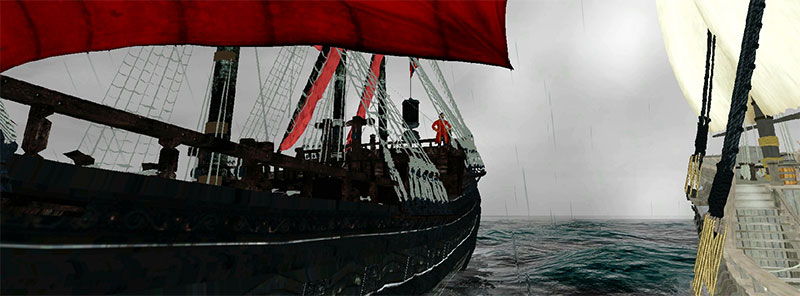
3D scenography for Victorian Opera’s 2015: The Flying Dutchman Image courtesy of Deakin Motion.Lab
Opera has always had a steadfast community of enthusiasts and now the work of Professor Kim Vincs, Director of Deakin University’s Motion Lab, is capturing new audiences through the use of digital technology.
Professor Vincs partnered with Victorian Opera in 2014 to study the potential impact of virtual scenography for touring performing arts companies. The project, funded by a Linkage Projects grant, draws on the technology used in video games to create dynamic, three-dimensional digital sets and characters that are projected on stage during live performances.
Large-scale set production in opera, ballet and theatre incurs significant costs and logistical difficulties, making it difficult to perform outside of traditional, metropolitan environments. The introduction of virtual scenography will enable touring companies to perform in previously inaccessible rural and regional areas.
In 2015, Professor Vincs’ research resulted in 3D stereoscopic imagery—images with spatial information that create depth to trick the brain into seeing 3D imagery—which was incorporated in the Victorian Opera’s production of The Flying Dutchman in Melbourne. Complete with virtual scenery and digital avatars based on motion-captured human action, this world first production received excellent reviews and was a 2015 finalist in the Unite Awards and Green Room Awards.
“Today, computer-generated imagery and interactive technologies are something that we are comfortable with, they’re a part of how we think. This project is about translating that into theatre,” says Professor Vincs.
She hopes that digital scenography will improve affordability, artistic experience and rural and regional access for professional artistic productions, bringing the performing arts to a wider and more diverse audience.
Case study 10: Outcomes of benefit
Converting carbon dioxide into clean energy
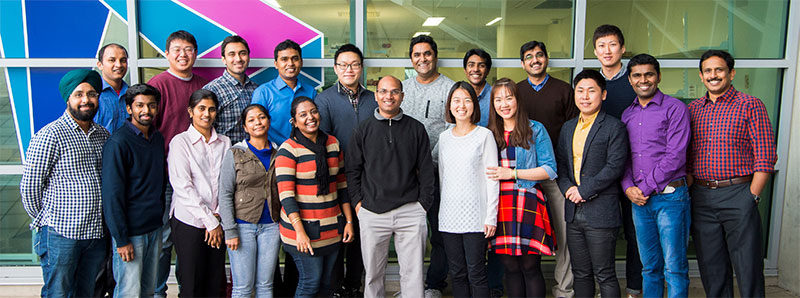
Professor Ajayan Vinu and his research group at The University of South Australia Image courtesy of The University of South Australia
Decreasing levels of atmospheric carbon dioxide and developing clean energy sources are two important research priorities in Australia’s response to climate change. Professor Ajayan Vinu, from the University of South Australia, is tackling both priorities.
Supported by a 2010 ARC Future Fellowship, Professor Vinu gained global recognition for his pioneering work in the development of nanoporous materials that are capable of capturing carbon dioxide from the atmosphere and converting it into a clean energy source.
Professor Vinu discovered that the chemical properties of carbon nitride, are ideal for capturing carbon dioxide molecules. This material has a semiconducting framework and ordered pores, supporting the conversion of carbon dioxide into a clean fuel, methanol, with the help of sunlight and water.
“Not only does this material present an effective method for cleaning up the environment, it offers a clean fuel source that will lower our carbon dioxide emissions going into the future,” said Professor Vinu.
Professor Vinu was also awarded a 2015 Discovery Projects grant to further his research into the development of clean energy technologies. The Future Fellowship also helped him acquire funding ($1.7 million) from Saudi Arabia Basic Industries Corporation, a multibillion dollar international chemical company, for a three-year research project that is focused on the utilisation of carbon dioxide into value added products using nanoporous catalytic materials. Professor Vinu, Professor of Nanomaterials at the Future Industries Institute, is taking an interdisciplinary approach, in collaboration with industry, to translate his work on nanoporous materials into real products and benefits.
Case study 11: Outcomes of benefit
Helium atoms help form high resolution images
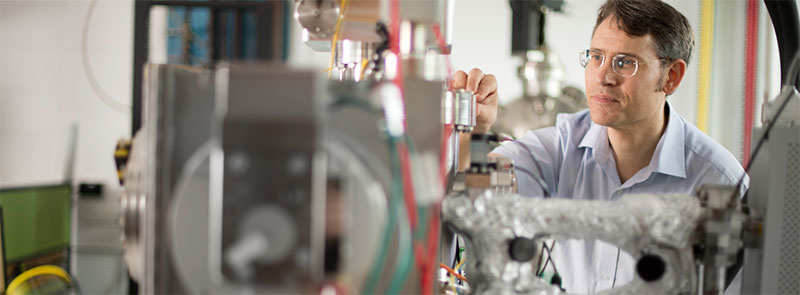
The University of Newcastle’s Professor Paul Dastoor with the breakthrough SHeM (Scanning Helium Microscope). Image courtesy of The University of South Australia
In 1625, Federico Cesi and Francesco Stelluti revolutionised the scientific world when they published their observations of honey bee anatomy as seen through a newly invented instrument—the optical microscope. Almost 400 years later, Professor Paul Dastoor and his team from The University of Newcastle, funded through the Linkage Infrastructure, Equipment and Facilities scheme, are again opening up scientific windows with a prototype scanning helium microscope (SHeM). The first high-resolution photos from the microscope were published in the journal Nature and fittingly revealed, among other things, the fine details of a honey bee.
Existing microscopes utilise energetic beams of particles or light that can damage or alter delicate materials. SHeM, however, uses a beam of extraordinarily low-energy neutral helium atoms to form images, enabling scientists to study a range of materials without disturbing them. After 20 years in the making, the prototype has been hailed as a scientific game changer, providing high resolution images without damage, thus making microscopy more accessible to a wider range of delicate materials.
Professor Dastoor believes that enormous scientific advances ensue every time a new microscope is developed. New insight on structures at a microscopic level open up the potential for practical applications in the fabrication of new materials, structures and devices. These developments could lead to anything from stealth technology to advances in solar energy or information technology.
Case study 12: Outcomes of benefit
New discovery safely removes Mercury from soil and water
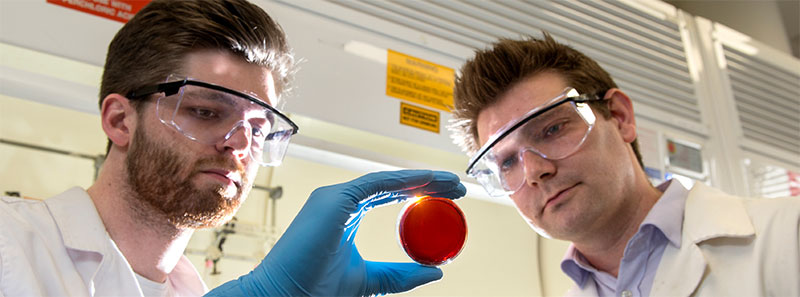
Flinders University researchers Dr Justin Chalker (right) and Max Worthington (left) examine their mercury-binding polymer, made entirely from industrial waste. Image courtesy of Ashton Claridge, Flinders University
What started as a research project to make a new type of polymer from easily available materials, has resulted in the development of a material that is made from two waste products and can permanently remove the toxic metal mercury from soil and water.
Dr Justin Chalker, a Discovery Early Career Researcher Award recipient, and his team at The Flinders University of South Australia found that while it was a simple process to make a polymer using sulphur—a widely available waste product from the petroleum industry—the end result was brittle and fell apart easily. After experimenting with various molecules that would react with sulphur, the team discovered that limonene, the main component of orange oil and a waste product of the citrus industry, could be transformed to sulphur-limonene polysulphide (SLP), which can be made into various shapes and easily stored.
With its high sulphur content, the team anticipated that SLP would bind with certain metals such as mercury, which it did. To add to the success, researchers found that the dark red polymer turned bright yellow when it absorbed mercury, indicating the presence of mercury in an environment. After contact with SLP, mercury becomes permanently bound to it and can be safely removed and stored. The polymer can remove over 50 per cent of mercury found in water after a single treatment.
SLP is non-toxic, a critical benefit that enables it to be used directly in natural ecosystems. The outcome of Dr Chalker’s findings is a product that can be utilised to remove mercury from groundwater and soil, in large-scale toxic waste clean-up and in water filters to provide safe drinking water world-wide.
Case study 13: Outcomes of benefit
Culture, language and identity
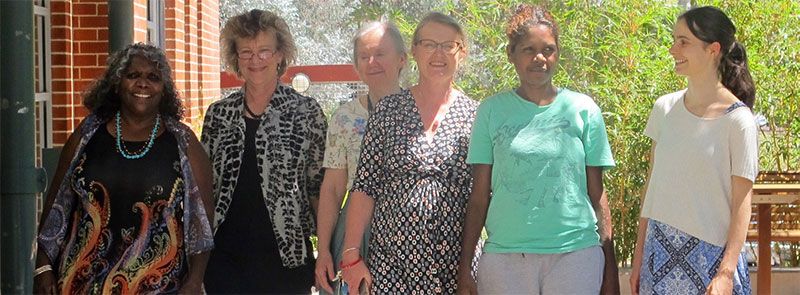
Left to Right: Elizabeth Ellis, Jennifer Green, Jane Simpson, Inge Kral, Natalie O’Toole, Alexandra Grant.
Language is intrinsically linked to indigenous peoples’ way of life, culture and identity underpinning roles, responsibilities and obligations in relation to one another as well as being rich repositories of history, information, and stories.
Elizabeth Marrkilyi Ellis, a Ngaatjatjarra woman from Tjukurla community in Western Australia, is working with team members Jane Simpson and Inge Kral at The Australian National University and Jennifer Green at The University of Melbourne (and research assistants Alexandra Grant, ANU and Natalie O’Toole a young Pitjantjatjara trainee from the Ngaanyatjarra Lands), to document and analyse endangered verbal art forms of the Ngaanyatjarra and Ngaatjatjarra people of the Western Desert as part of a project funded through the Discovery Indigenous scheme. Ms Ellis is a Discovery Australian Aboriginal and Torres Strait Islander Award recipient.
An educator, interpreter and linguist who speaks several dialects of Western Desert languages, Ms Ellis’ insight into the intricacies, subtle non-verbal cues and connotations of communication has been essential in capturing, analysing and preserving the languages. This includes storytelling, sign language and the special speech styles used to mark occasions and life transitions. According to Ms Ellis, preserving the stories and knowledge embedded within the languages can help change people’s perceptions of their lives and empower both Indigenous and non-Indigenous communities alike. “You learn to respect other peoples, you learn to respect other people’s culture and you learn to respect other people’s world views”.
Ngaanyatjarra and Ngaatjatjarra are still spoken by children, and Ms Ellis and her colleagues hope that these children will soon be able to discuss, analyse and master the subtler endangered aspects of these languages, in school and out of school. This will help ensure that the knowledge and culture these languages represent is not lost to future generations.
Case study 14: Outcomes of benefit
Printing sensors to monitor sun exposure
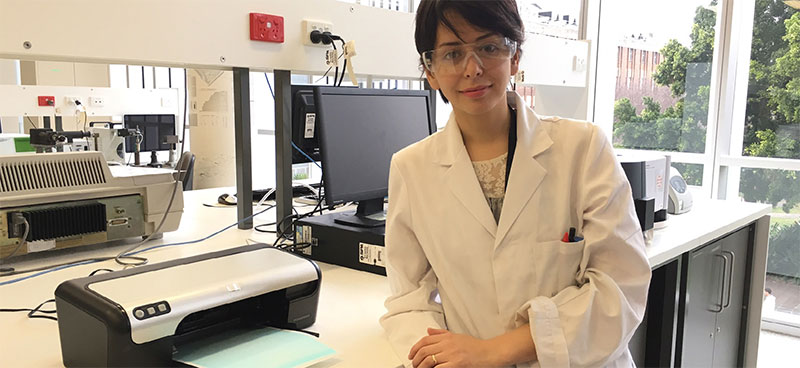
PhD candidate Parisa Khiabani holding the low-cost paper based sensor developed by Scientia Professor Justin Gooding and his team at The University of New south Wales. Image courtesy of Mehran Bolourian Kashi
Australians love a sunburnt country, but sunburnt skin is another matter! Sunburn is a leading cause of skin cancer, one of the most commonly diagnosed cancers in Australia. Professor Justin Gooding and his team from the ARC Centre of Excellence in Convergent Bio-Nano Science and Technology have developed a new sensor for monitoring sun exposure that could save lives.
The sensor is prepared using an inkjet printer and paper, along with non-toxic titanium dioxide (a mineral found in cosmetics such as sunscreen), polyvinylpyrrolidone (a binding agent found in cosmetics) and food dye.
Sun exposure that does not result in burning can still cause damage to skin cells and increase the long-term risk of developing skin cancer. The sensor provides feedback on levels of sun exposure and has the potential to become an important educational tool to inform users of their level of UV exposure. When enough UV radiation hits the sensor, titanium dioxide causes the dye to change colour providing a visual indication that alerts the wearer to apply more sunscreen or to seek shade.
Unlike existing UV sensors, the product can be calibrated to take into account different skin tones and the SPF of sunscreens that are applied to the skin.
According to the researchers, the technique is inexpensive, easy to use and easy to fabricate. Intelligent innovation such as the sun exposure sensor, when incorporated into wearable technology or as a stand-alone product, could contribute to educating users to be sun smart.
Case study 15: Outcomes of benefit
Basin modelling to boost Australian industries

Professor Dietmar Müller and his colleagues are using big data to create models of sedimentary basins. Image courtesy of Doug Thost
Sedimentary basins are vital for Australian industry energy resources and can reveal the history of Earth’s sea levels, climate and surface topography. Sedimentary basins contain multi-layered, permeable rocks and are being increasingly relied upon by industry to capture oil, gas, geothermal energy and ground water.
Previous approaches to analysing sedimentary basins have been based on two-dimensional methods, but increasing resource competition has called for increased sophistication in resource management. The ARC Industrial Transformation Research Hub for Basin Geodynamics and Evolution of Sedimentary Systems, led by Professor Dietmar Müller from The University of Sydney, is using complex computer systems to create five-dimensional models of sedimentary basins. This will have enormous implications for industry, extending visibility to complex, inaccessible remote and deep exploration targets.
The project draws on a number of data sets to create these five-dimensional models, using space and time with uncertainty estimates that combine the evolution of mantle flow, crustal deformation, erosion and sedimentary processes to achieve a quantum leap in basin modelling. The Hub is using the models to research the ways in which the earth’s surface and deep earth processes interact to form sedimentary basins and other geo-physical phenomena.
Improved understanding of the diversity of geological processes will cultivate new methods of basin exploration and management. Professor Müller said the project will highlight what resources might be found in particular basins in remote areas of Australia, providing the mining, exploration and energy sectors with an ‘exploration geodynamics toolbox’.
This technology, fusing Big Data with Basin Models through space and time, has built on over ten years of software development and global research leadership of the EarthByte Group and their partners, based at The University of Sydney School of Gesociences. The new approach, some of the first of its kind globally, addresses a variety of issues in the context of basin structure and evolution for sustainable earth resource extraction and management.
Case study 16: Outcomes of benefit
3D printing revolutionising bone replacement
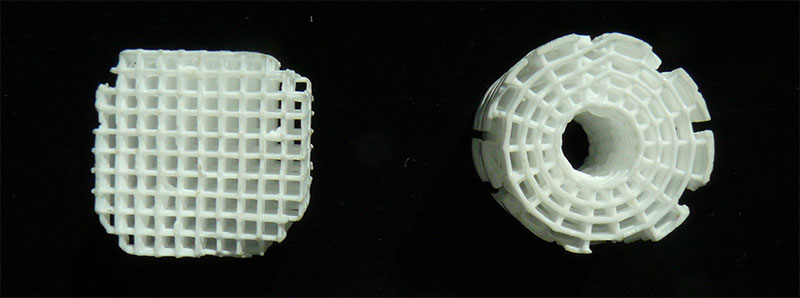
3D printed synthetic scaffolds for skeletal tissue regeneration developed by Professor Hala Zreiqat of The University of Sydney.
The demand for effective and affordable bone replacement is increasing with Australia’s ageing population. Metal implants are expensive, prone to complications and sometimes need replacing.
A team at The University of Sydney, funded by the Linkage Projects scheme and led by Professor Hala Zreiqat, has partnered with a prosthesis manufacturer to develop a revolutionary bioceramic material used to treat large bone defects resulting from accidents, injury or disease. The team is using computational modelling and 3D printing to create synthetic implants that will fit exactly within the bone defect.
The synthetic bone material mimics the highly porous nature of natural bone, allowing for the penetration of blood and nutrients. It is 100 times stronger than other synthetic materials used in the field that are often not strong enough to withstand high pressure and loading.
Unlike other implants, the material is not a permanent replacement; rather, it serves as a scaffold for the regeneration of new bone. The composition of the material has been carefully designed, incorporating trace elements that are essential for bone formation.
Professor Zreiqat said “the material stimulates natural bone growth from both sides of the defect, without the introduction of cells or biological agents. As the bone grows, the material dissolves. What you’re left with is strong, natural bone”.
Successful trials have demonstrated remarkable bone regrowth with no apparent side effects. Importantly, the results so far show that the material is not rejected from the body. Professor Zreiqat’s discovery will replace the requirements for bone grafts and will be commercially available within 5 years.